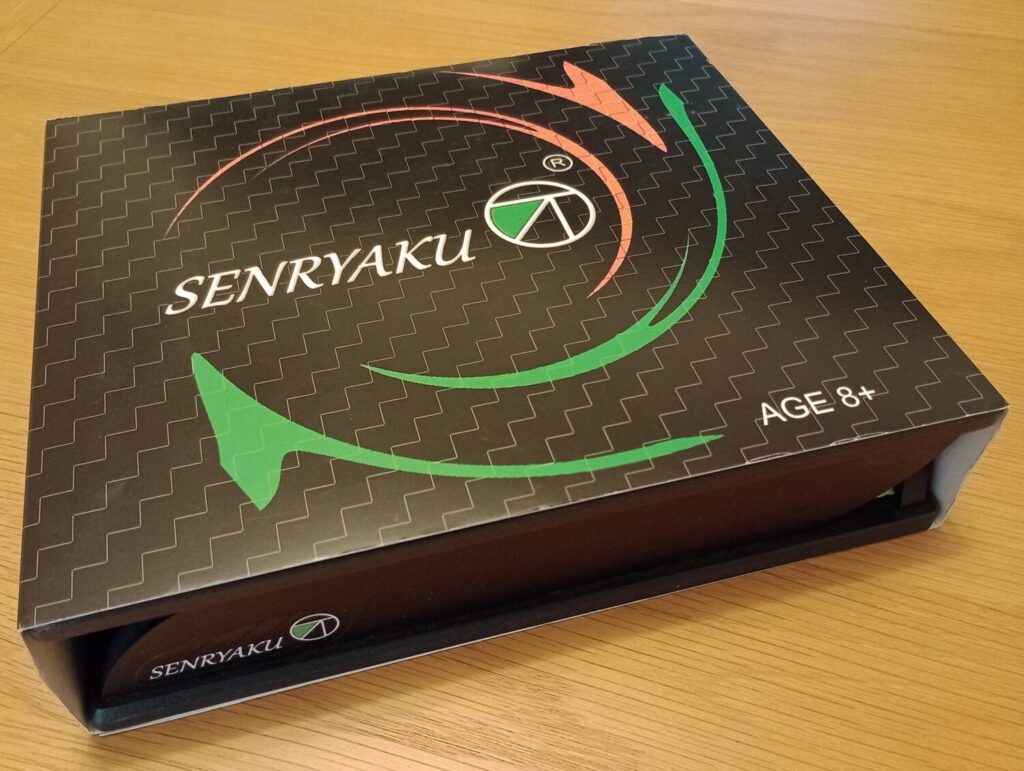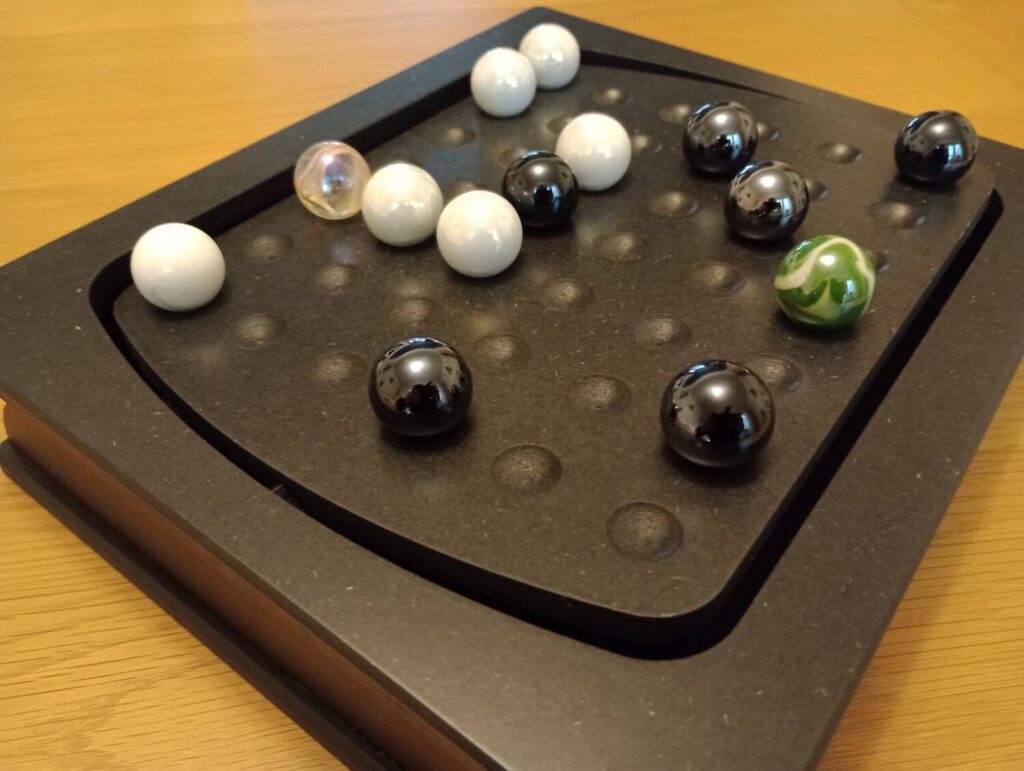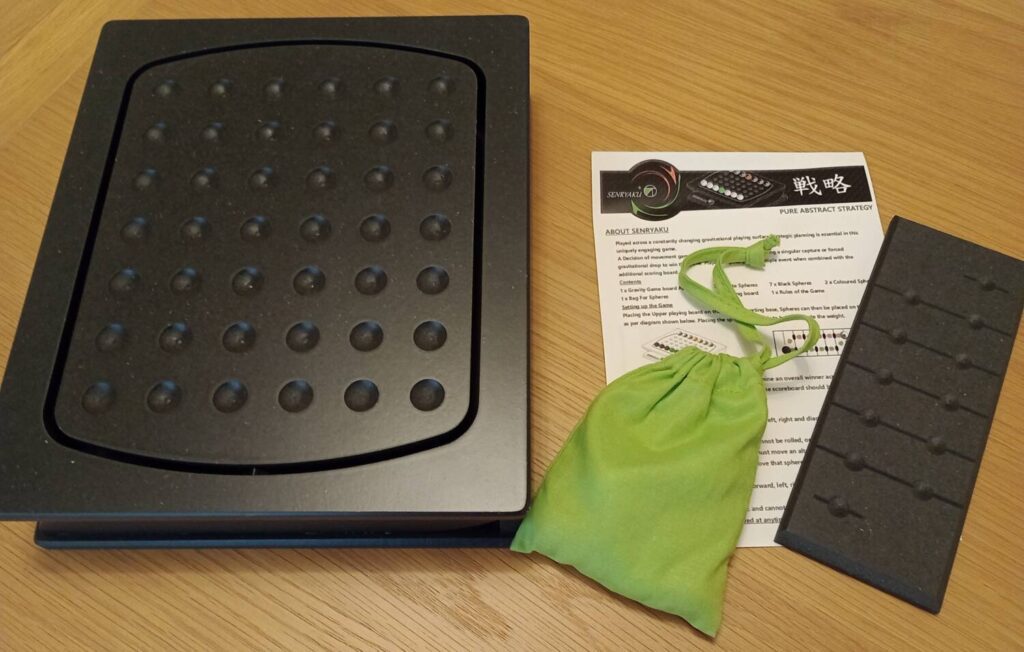In the hubbub of Airecon in March 2023 my attention was drawn by the convention centre spotlights glinting off large, polished spheres, lined up like sleeping warriors ready to be awoken. The background noise seemed to fade away as our focus narrowed on this curio and we sat down to play. ‘Come’ said the host, with a knowing calm that suggested he had been expecting us, ‘Sit. And listen.’ A few minutes was enough to etch this game into my memory – no mean feat amongst thousands of others that weekend. Adding to the mystery was the fact I could not seem to find the game for months after – I was starting to think it had all been a dream, when a contact handed me a parcel with the unmistakable clack of marbles within…

Do not use a canon to kill a mosquito
Senryaku’s box is efficiently packaged – a simple card sleeve just about covers the dignity of the game structure itself, which comprises the playing board with shallow wells in a 7 x 6 grid, plus the base. Each player lines up seven spheres, including a monarch (let’s be equal rights about it) in the middle – with the aim of capturing that unelected hereditary ruler from your opponent whilst protecting your own. The twist, pun intended, really comes in the base – the board rests on two pivots, perfectly balanced, suspended above the cavernous hollow interior beneath. This allows the board to tilt, like a see-saw, when spheres are moved as the game progresses.

The primary aim is to manoeuvre your troops to where you can make a single-space assault on the enemy royal personage. An insightful parameter from the designer, Stephen Yates, is to disallow a player from moving the same sphere on two successive turns – which must at least double or square the number of moves you have to think ahead (maths, anyone?). A beginner over their first few games learns to treat their spheres as a pack of patient hunting dogs, steadily cornering their prey, ever watchful that it can leap clear if left even a small gap. This would be average enjoyment – a poor man’s chess – were it not for the pivots. As spheres are moved and the weight distribution changes, the board begins to tilt…

Thus the other way to win is if your opponent “crashes” the board, i.e. moves a sphere too far forward, the straw breaking the camel’s back and sending the whole caravan tumbling into the abyss. This novel feature pulls your strategy into a second dimension and it takes a few more games to retrain the brain to think along these two disjointed axes simultaneously. Confident of your superior positional play, you may be going in for the killing stroke, only to tip the board and see all your spheres, hopes and dreams, slide below. At an advanced level, your opponent may even actively take a defensive stance, very much the Mr Miyagi to your John Kreese, luring you to advance then bowing respectfully as you self-destruct.

After several dozen games, experienced opponents will now tread carefully. Spheres can move forward, diagonally forward, or sideways, but never backward. This brings a no-way-back mindset, and you can find yourself in a position of knowing the next move will either fatally open up your formation, or cause gravity to take over – the rules specify no draws, so at this point you must commit hara-kiri.
The prohibition on moving the same sphere twice successively caught me out a number of times when planning my attacks – note also that this rule does not apply to the monarch sphere, which can make a final desperate bid to avoid capture. Sometimes this gives sufficient time for a counterpunch, but more than once my chieftain has leapt out of the frying pan and into the board-crashing fire. The loud clacks of rolling marbles is enough to make you jump, adding a certain drama to the denouement!
Better a diamond with a flaw than a pebble without one
Mahogany in colour and eerily smooth to the touch, the board and base are engineered wood, using organic colouring agents and Forestry Commission approved timber. The spheres are marble, one set jet black and shimmering like onyx, the other white as pearl. The monarchs are more captivating still – one jade green and the other translucent like a bubble, and both streaked with milky white or sunset pink. With an old-school drawstring bag to pack away the spheres, and a couple of exotic swirls on the outer case, the whole thing has the feel of a deep and soulful traditional pastime, topped off by the name – ‘senryaku’ is the Japanese word for ‘strategy’. The creators, designer Stephen Yates through his own publishing company Playkit Games, have managed to invent a fairly new game concept as recently as 2015 and yet still make it feel like it has a thousand-year history.

I only found a couple of minor downsides. Firstly, the instructions have room for improvement. Unfortunately, lacking quality in wording, design, layout, grammar, diagrams and printer ink, the leaflet is made to look flimsy and out of place next to the sleek playing board itself. Happily these documentation ills can surely be remedied in future editions. Secondly the drawstring bag, holding the spheres when packed away, has a colour somewhere between lime and grass green – a more subtle tone would be more in keeping with the game’s samurai-antique-shop vibe – and I’d love to see the kanji for ‘senryaku’ printed on the bag too.

Also in the box is a scoreboard, of the same stylish material as the playing board, with further wells and two additional spheres – also handy for spares. In this way the creators neatly prompt players to a match of first to five, which feels like a good length to satisfactorily draw out the better strategist. Played over a cup of green tea or warm sake, single games might last 5-10 minutes. I found drawing swords with a worthy adversary a great way to pass 30-45 minutes. Easy to learn and hard to master, I was even able to get my 7- and even 5-year-old to play. Tactile, and not requiring reading game cards for example, lowers the barriers to play and we genuinely all enjoyed playing this as a family.
Sure, it’s not for an epic, sprawling all-nighter but nor is it trying to be – there is definitely beauty in simplicity here and with a few finishing touches we may have an instant classic on our hands.







Add Comment